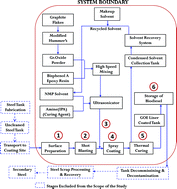Sustainability of renewable fuel infrastructure: a screening LCA case study of anticorrosive graphene oxide epoxy liners in steel tanks for the storage of biodiesel and its blends†
Abstract
Biodiesel is a widely used fuel that meets the renewable fuel standards developed under the Energy Policy Act of 2005. However, biodiesel is known to pose a series of abiotic and biotic corrosion risks to storage tanks. A typical practice (incumbent system) used to protect the tanks from these risks include (i) coating the interior surface of the tank with a solvent-free epoxy (SFE) liner, and (ii) adding a biocide to the tank. Herein, we present a screening-level life-cycle assessment study to compare the environmental performance of a graphene oxide (GO)-epoxy (GOE) liner with the incumbent system. TRACI was used as an impact assessment tool to model the midpoint environmental impacts in ten categories: global warming potential (GWP, kg CO2 eq.); acidification potential (AP, kg SO2 eq.); potential human health damage impacts due to carcinogens (HH-CP, CTUh) and non-carcinogens (HH-NCP, CTUh); potential respiratory effects (REP, kg PM2.5 eq.); eutrophication potential (EP, kg N eq.); ozone depletion potential (ODP kg CFC-11 eq.); ecotoxicity potential (ETXP, CTUe); smog formation potential (SFP kg O3 eq.) and fossil fuel depletion potential (FFDP MJ surplus). The equivalent functional unit of the LCA study was designed to protect 30 m2 of the interior surface (unalloyed steel sheet) of a 10 000 liter biodiesel tank against abiotic and biotic corrosion during its service life of 20 years. Overall, this LCA study highlights the improved environmental performance for the GOE liner compared to the incumbent system, whereby the GOE liner showed 91% lower impacts in ODP impact category, 59% smaller in REP, 62% smaller in AP, 67–69% smaller in GWP and HH-CP, 72–76% smaller in EP, SFP, and FFDP, and 81–83% smaller ETXP and HH-NCP category results. The scenario analysis study revealed that these potential impacts change by less than 15% when the GOE liners are functionalized with silanized-GO nanosheets or GO-reinforced polyvinyl carbazole to improve the antimicrobial properties. The results from an uncertainty analysis indicated that the impacts for the incumbent system were more sensitive to changes in the key modeling parameters compared to that for the GOE liner system.



 Please wait while we load your content...
Please wait while we load your content...